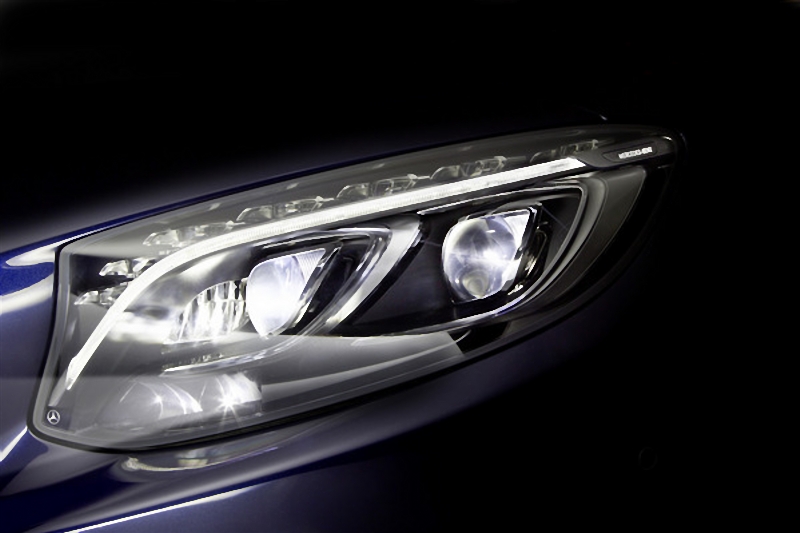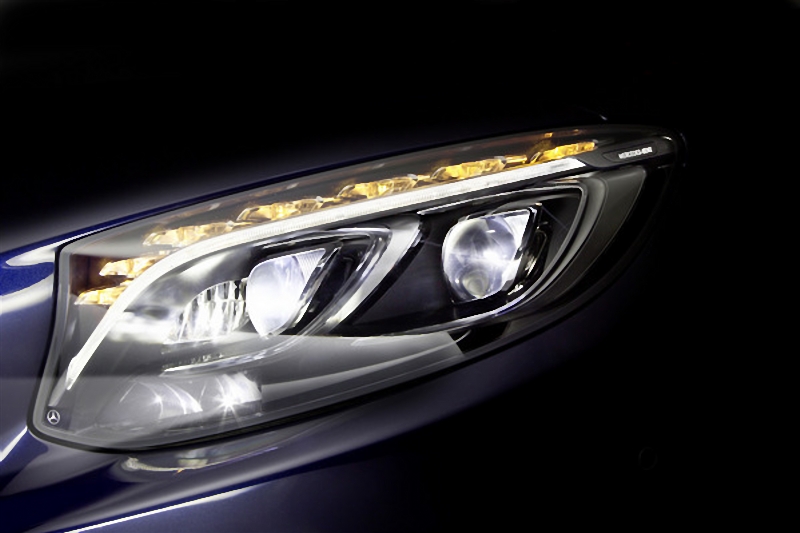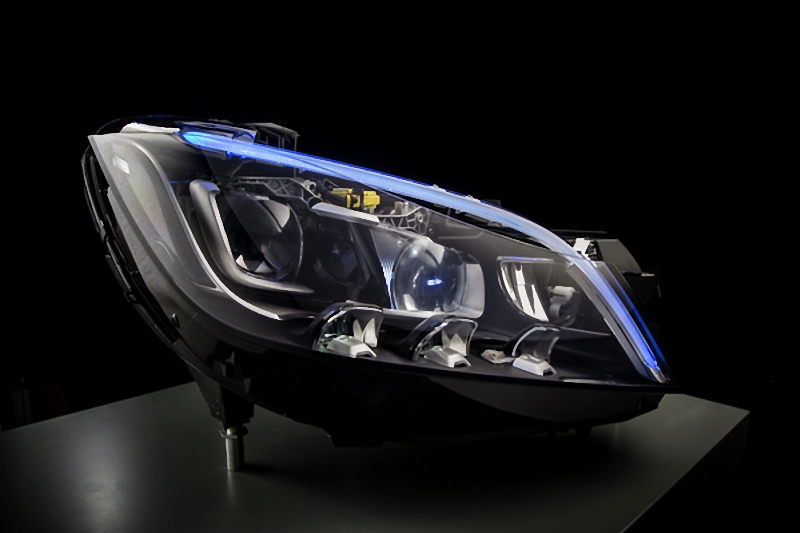Mercedes Benz to Provide Next Generation Multibeam LED Headlamp
07-01-2015

Light pioneer Mercedes-Benz provides an outlook of what the future holds: instead of the 24 LEDs of the gridded high beam module in the CLS headlamp, 84 LEDs per headlamp will soon be achieving for even better light quality and even greater safety at night. In the medium term, as many as 1024 pixels per LED will enable the best lighting performance of the road at every speed and in all traffic conditions – and without dazzling other road users.
These developments in light technology form part of a continuing tradition: around 500 LEDs were used to all the lighting functions on a car for the first time on the S-Class in 2013. In 2014 the MULTIBEAM LED headlamps on the new CLS-Class raised the criteria once again with their precision LED light grid modules. The statistics show just how important such precision lights are: at night-time, the risk of accidents increases greatly. Five times as many pedestrians are killed on country roads as during the daytime. Although night-time driving on country roads accounts for only 20 percent of total drive, 40 percent of all serious accidents occur here during the night . Over 120 years of headlamp technology at Mercedes-Benz stand for ongoing progress in the interests of enhanced road safety and the introduction of innovations to benefit the companys customers and other road users.

Enabling ideal visibility in all driving situations without dazzling other road users has always been our credo in developing new light systems. Mercedes-Benz is pursuing the further development of LED lights technology to this end."
The added safety provided by the MULTIBEAM LED technology becomes obvious above all in real traffic situations: in contrast to static high beam systems, some of which have long ranges, MULTIBEAM LED also supports the driver when there are other vehicles in the field lighted by the headlamps. By means of totally independent control of the individual LEDs of the gridded light source, the MULTIBEAM LED headlamp is able to mask other road users out of its light distribution in a fraction of a second, thereby enabling high beam to remain on. This assures the driver of the best possible light performance at all times, without dazzling other road users.
In the near future, Mercedes-Benz will be adding an additional HIGH RANGE LED high beam into its LED headlamps. This additional high beam uses state-of-the-art high-performance LEDs to provide high beam ranges of over 600 m in driving situations without any oncoming traffic or vehicles ahead. In contrast to the current "laser headlamps", LED technology achieves this performance at markedly lower costs and with a manageable degree of complexity. At the same time, it also enables Mercedes-Benz to exploit the legally permissible level of lighting in Europe virtually to the full level. This applies regardless of the light source used in the headlamp for all manufacturers.
When it comes to the number of pixels, the same is true of LED headlamps as of a digital camera: the more the better. The higher the number of individually controllable pixels, the more finely the light can be controlled and adapted to different conditions. A high resolution enables an increase in both precision and brilliance. Here is an overview of LED technology today, tomorrow and in the more distance future.
In 2014, Mercedes-Benz introduced the innovative MULTIBEAM LED headlamps in the CLS-Class . These are fitted with 24 individual high-performance LEDs. Each one of these LEDs can be individually electronically controlled. "Gridding" the light in this way allows the light distribution from the right and left headlamps to be controlled entirely separately and adapted to the traffic conditions with a high level of dynamism. This enables the individual areas of the road surface to be illuminated in a very specific manner. The headlamp control technology combines the gridded light source with the proven mechanical technology of the LED Intelligent Light System, and the high-performance LEDs provide for a range of 485 m.
Mercedes-Benz will soon be releasing MULTIBEAM LED headlamps with a gridded light source containing 84 LEDs, enabling even higher resolution of the light output. This will provide other road users even better protection from dazzling, while improving lighiting on the road ahead for the driver. As a result of the absolutely freely configurable light distribution, it is possible for the first time to achieve all high- and low-beam functions of the Intelligent Light System in entirely digital mode and without any mechanical actuators. This will make a wealth of new, adaptive light functions possible which will render night-time driving yet safer for both the driver and other road users.
This technology is set to develop at a rapid pace: In the medium term 1024 individually controllable pixels per LED chip will enable a further improvement in night-time visibility, resulting in further enhanced safety.
The partners Infineon, Osram, Fraunhofer Gesellschaft IZM, Hella and Daimler have just made a breakthrough in the "μAFS" research project in the form of a new type of LED chip with an extremely fine structure. Monolithically structured pixel LED semiconductor layers are built up on a silicon substrate which, via the integration of circuit parts, allows the selective control of more than 1024 individually addressable pixels per LED chip. This LED technology developed in the project sponsored by the Federal Ministry for Education and Research (BMBF) is to be installed and tested in a Mercedes-Benz experimental vehicle in 2015.

A Nobel Prize-winning innovation features on board every Mercedes-Benz with LED headlamps: Next month, the physicists Shuji Nakamura (*1954), Isamu Akasaki (*1929) and Hiroshi Amano (*1960) will receive what surely is the worlds most highly reputed science award for the development of blue LEDs. This invention enables light sources to be scaled down, subsequently making it possible to use them in automotive LED headlamps. At present, it is thus possible to fit up to 100 LEDs with lighting surfaces in the millimetre range behind a lens.
The idea of partial high beam goes back still further: in the face of ever denser traffic in the 1950s, computer pioneer Konrad Zuse (1910-1995) came up with a proposal for combining maximum lighting distribution of the road with minimal irritation of oncoming traffic. Zuse employed several headlamps, each of which lit part of the road and could be turned off by means of photocells when the latter detected other cars within their range. In 1958 he had this "Lighting system, photoelectrically controllable by counter light" registered by the German patent office under the number 1190413. This partial high beam did not go into series production until this year, however, with the world premiere of the MULTIBEAM LED headlamp in the Mercedes-Benz CLS.


